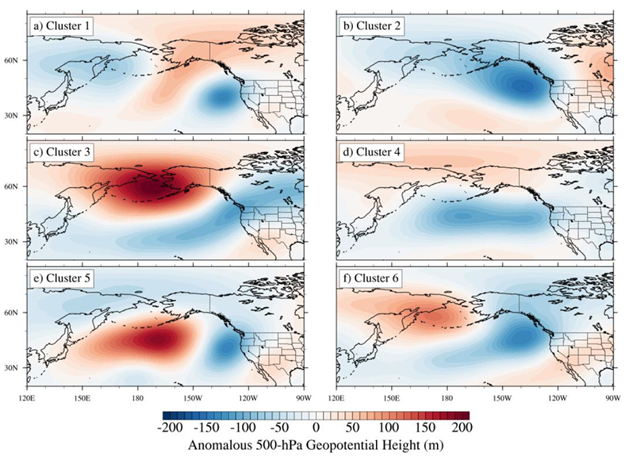CW3E Publication Notice
Large-scale environments of successive atmospheric river events leading to compound precipitation extremes in California
January 13, 2022
Recent CW3E PhD graduate student, Dr. Meredith Fish, along with co-authors Dr. James M. Done (Capacity Center for Climate and Weather Extremes, National Center for Atmospheric Research), Dr. Daniel Swain (Institute of the Environment and Sustainability, University of California, Los Angeles), Dr. Anna M. Wilson (Center for Western Weather and Water Extremes (CW3E), Scripps Institution of Oceanography, University of California San Diego), Dr. Allison C. Michaelis (Department of Geographic and Atmospheric Sciences, Northern Illinois University), Dr. Peter B. Gibson (CW3E; National Institute of Water and Atmospheric Research, New Zealand), and Dr F. Martin Ralph (CW3E), recently published an article in Journal of Climate, titled “Large-scale environments of successive atmospheric river events leading to compound precipitation extremes in California”. The paper contributes to the goals of CW3E’s 2019-2024 Strategic Plan to support Atmospheric River (AR) Research and Applications by examining the large-scale environments and mechanisms associated with these successive Atmospheric River (AR) events, known as AR families.
This study utilizes a new reanalysis-based 39-year catalog of 248 AR family events affecting California between 1981 and 2019 to evaluate the large-scale conditions linked to these
successive events and their relationship to precipitation along the U.S. West Coast. In evaluating this dataset, the study seeks to 1) understand the characteristics of AR families and their causative processes, 2) to examine relationships between AR families and modes of climate variability, and 3) to quantify the precipitation accumulation associated with AR families.
Using K-means clustering on the 500-hPa geopotential height field, Fish et al. identify six distinct clusters of large-scale patterns associated with AR families (Figure 1). Two clusters are of particular interest due to their strong relationship with phases of the El Niño/Southern Oscillation (ENSO). One of these clusters is characterized by a strong ridge in the Bering Sea and Rossby wave propagation, most frequently occurs during La Niña and neutral ENSO years and is associated with the highest cluster-average precipitation across California. The other cluster, characterized by a zonal elongation of lower geopotential heights across the Pacific basin and an extended North Pacific Jet, most frequently occurs during El Niño years and is associated with lower cluster-average precipitation across California but a longer duration. In contrast, Fish et al. find that single AR events do not show obvious clustering of spatial patterns. This difference presented by the study suggests that the potential predictability of AR families may be enhanced relative to single AR events, especially on sub-seasonal to seasonal timescales.
The results from this study enhance understanding of the large-scale variability relevant to successive AR events affecting California, which has previously gone largely unexplored. Given that many of these events produce extreme precipitation, these findings present important implications for water and flood management, and meteorological and hydrologic hazard mitigation.
Figure 1: K-means clustering (k=6) on anomalous 500-hPa geopotential heights (shaded, m) for
all timesteps within AR families. Cluster 1: n=1524, Cluster 2: n=2058, Cluster 3: n=911, Cluster 4: n=1681, Cluster 5: n=1160, Cluster 6: n=990.
Fish, M.A., Done, J.M., Swain, D.L., Wilson, A.M., Michaelis, A.C., Gibson, P.B., Ralph, F.M. (2021). Large-scale environments of successive atmospheric river events leading to compound precipitation extremes in California. Journal of Climate. https://doi.org/10.1175/JCLI-D-21-0168.1

